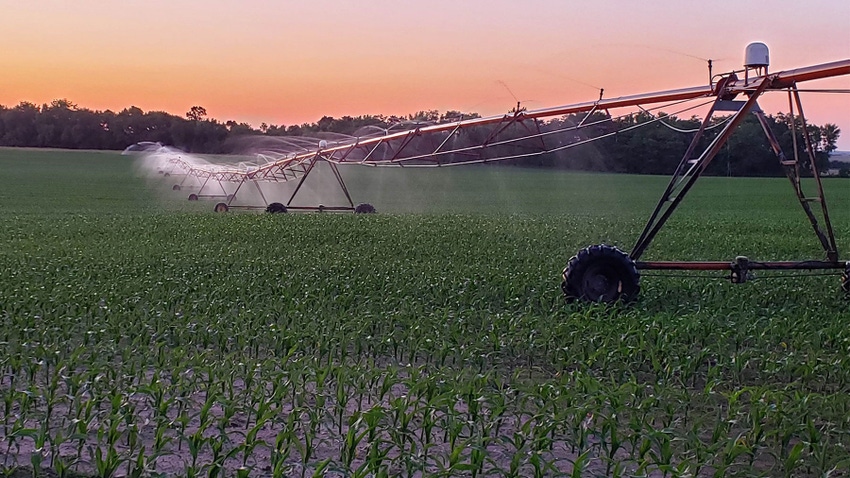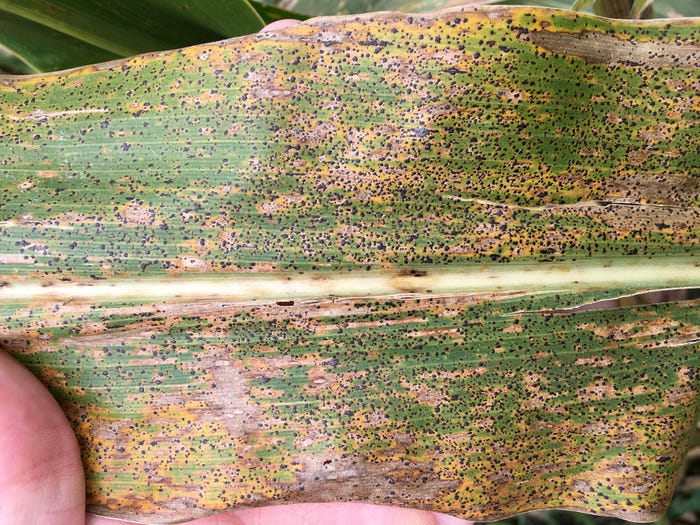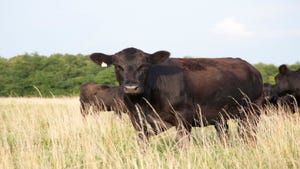
At a Glance
- Have less in-season irrigation events.
- Scout for tar spot close to pivots first.
- Monitor soil moisture all season.
For Alyssa Koehler, it’s been a question of when, not if, tar spot would begin to threaten Delaware cornfields.
This past October, the Extension plant pathologist at the University of Delaware got her question answered. “We confirmed tar spot on farms in Kent and Sussex counties,” she said at the recent Delaware Ag Week event in Harrington.
University experts say the corn disease thrives in cool (59-70 degrees F), humid conditions (85% relative humidity), with long periods of leaf wetness (more than 7 hours). With its sandy, porous soils, irrigation is common on farms throughout the peninsula.
And now that tar spot is here, it raises a big question: How bad can irrigation make a potential tar spot outbreak, and how should rigs be managed? Early research from farther West is providing clues.
In Nebraska, where more than 7 million acres are under irrigation, tar spot has been found in 47 of the state’s 93 counties. It has just started to touch the eastern edges of some of the state’s most heavily irrigated farmland, says Tamra Jackson-Ziems, University of Nebraska plant pathologist.
It was first confirmed in October 2021. Since then, it has popped up earlier, in August and September, especially under irrigation.
“We create a favorable environment in the way that we manage our crop sometimes, and so we’re trying to learn more about that,” Jackson-Ziems says.
Where to look
One thing is clear: Scouting under a pivot is the best place to find tar spot early. Examine corn leaves for circular-to-diamond-shaped, black, tar-like spots, which usually have a slightly raised appearance and feel bumpy to the touch.
“That’s something where we’ve been able to find it quicker, keeping in mind that this past year we had a pretty substantial drought over most of eastern Nebraska where the disease is. It was a pretty severe drought, and we didn’t see it, except for places where it was irrigated,” Jackson-Ziems says. “When we’re under drought stress and we have water available through irrigation, we tend to use it, and sometimes maybe overuse it in some areas. This might make us think differently about how frequently we irrigate.”

LOOK FOR SPOTS: Tar spot appears as small, raised black spots scattered across the upper and lower leaf surfaces of corn. It’s easiest to see on green tissue, but it can also be found on dried leaves and fodder. (Photo by Chris Torres)
Jackson-Ziems and one of her graduate students are in the middle of a multiyear study looking at tar spot on irrigated farmland. She has also teamed with irrigation engineers at the university to look at the mechanics of center-pivot rigs and how those can make the disease spread more easily.
Preliminary data show that leaves stay wetter for longer near the center of a pivot. This could make for more favorable conditions for tar spot development.
“If you think about that, just the way the pivot moves, the whole thing moves in a straight line as it goes all the way around, but the inner span is moving slower,” Jackson-Ziems says. “It’s still putting out the same overall volume of water, but mechanically speaking, it is putting out a lighter volume of water in those inner spans. It keeps the leaves wetter, longer. They can be wetter for up to several hours.”
How should this affect the way growers manage pivots in relation to tar spot? Martin Chilvers, Michigan State plant pathologist, says irrigators need to up their management game.
“I’ve definitely had enough visits with farmers where there’s been lack of irrigation management, and that’s led to tar spot issues,” he says.
An example of this, Chilvers says, was a study last year of two fields in Michigan that had the same planting date and nutrient applications. One field was “smoked” with tar spot; the other was not.
The field with tar spot was accidentally soaked by a broken well. Along with that, the producer in the tar spot-infested field applied a half-inch of water twice a week, while in the other field, the farmer applied 1 inch of water only once a week.
“It showed me that frequent irrigation, without a doubt, can help cause tar spot,” Chilvers says.
An evolving disease
When tar spot was first identified in Pennsylvania’s Lancaster County in October 2020, it made big news because of past outbreaks in the Midwest that caused major yield losses.
The disease has since spread to most areas of the state, but no widespread yield-busting outbreaks have occurred — yet. That’s mainly because it appears too late in the growing season to affect corn yields.
That’s good news for growers, but it’s challenging for researchers such as Alyssa Collins, Penn State Extension plant pathologist, who needs the disease to replicate in order to test fungicides and management methods that can then be passed on to growers.
“People want to know how to prepare and when to pull the trigger on a fungicide,” Collins says.
Researchers’ understanding of tar spot continues to evolve, as shown by a study published in December in the journal Nature Portfolio.
In the study, done between 2018 and 2022 of over 588 observation stations throughout the Midwest, researchers found that the two biggest factors for tar spot development were temperatures between 65 and 74 degrees and ample moisture.
Surprisingly, the more humid it got, the less prolific the disease was. The study showed that relative humidity up to 75% was ideal for disease, but anything above 75% was not good for disease development.
“That surprised me for sure,” Collins says. “We don’t see fungi being held back by high moisture and humidity.”
A plan of attack
Managing tar spot starts with picking a hybrid that has good resistance, Michigan State’s Chilvers says. Also, planting multiple varieties is good, so you don’t put all your eggs in one basket. And if you are irrigating, Chilvers recommends drop nozzles instead of overhead nozzles.
Most importantly, though, is calibrating the irrigation rig to ensure it is working properly.
“Really when it comes to irrigation management, you want to make sure the system is calibrated, that you know how much water you’re putting on, and that your system is equal across the field,” Chilvers says. “And be aware of how much you’re putting on and also monitoring soil moisture, so you’re not irrigating too frequently.”
If conditions are favorable, the best timing for fungicide application, he says, is between tassel and R3 or R4 corn.
“We see that really early applications really have no value for tar spot management because they wear off too quick,” Chilvers says. “And just be mindful of your expectations for that fungicide. It will certainly suppress disease, but it won’t eliminate it.”
Crop rotation and even some tillage can help some, but it doesn’t play a major role in controlling the disease.
“With tar spot it doesn’t seem to matter, and I think part of the reason is that disease inoculum just blows in from outside,” Chilvers says.
Unanswered questions
Both Koehler and Collins agree that until there is more occurrence of the disease, questions will remain about best management practices.
For irrigated acres, Koehler says growers need to keep a close watch.
“A lot of it is going to come down to figuring out the timing, and what we do know from some observations in other states is that it seems like frequent irrigation, or lighter irrigation events that are more frequent, are potentially going to increase that disease pressure,” she says.
“Leaf wetness is the driver there. And so I think we may have to play around with some of our timings or approaches so that we’re getting the water that we need, but then also allowing that canopy to dry out and not just have extended periods of prolonged leaf wetness that can drive some of the conditions that favor tar spot.”
Collins agrees.
“Tar spot is just a disease that growers will have to talk about from now on,” she says. “But there’s still lots of questions that, thus far, don’t have easy answers.”
About the Author(s)
You May Also Like






